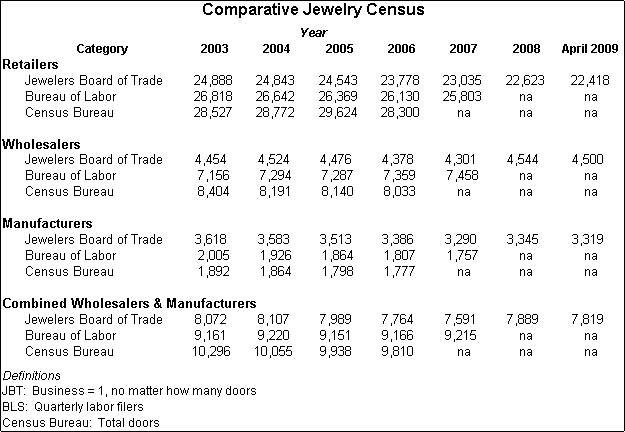IDEX Online Research: Jewelry Census Comparisons Summarized
June 16, 09
Several of our loyal readers of IDEX Online Research – who are also armchair analysts and keep a close watch on the data we publish – asked if we could present recent jewelry census data on one table for comparison purposes.
As we have previously noted, we like to have at least three sources to confirm our research data. There are three sources in the U.S. for the jewelry census, including retailers, wholesalers, and manufacturers. However, one source is substantially different from the other two. Census data from the Jewelers Board of Trade (JBT), which is the credit watch-dog of the industry, are notably different from the Census Bureau and the Department of Commerce. This is because the JBT counts jewelry retailers, wholesalers and manufacturers differently from the government census pollsters.
Here is an explanation of the U.S. jewelry industry census statistics shown on the table below:
- Jewelers Board of Trade – The JBT tallies jewelry retailers, wholesalers and manufacturers on a monthly basis. The JBT census counts a multi-store chain as one in its census, regardless of the number of stores which it operates. Thus, JBT numbers represent the number of jewelry businesses in the U.S. Further, the JBT numbers miss a few of the smaller businesses; those missed by its census are inconsequential in the industry, in our opinion. We believe that the JBT census is the most reliable and up-to-date.
- Bureau of Labor Statistics – The BLS census tallies those jewelers, by individual store, who are large enough to report quarterly employment statistics. Each store in a chain is counted in the BLS census. The BLS census does not count very small jewelry businesses, and those missed by its census are inconsequential to the industry.
- Census Bureau – The Census Bureau claims that it tallies the total number of individual jewelry doors in the U.S. As a result, its census numbers are the largest. However, the Census Bureau numbers run up to two years behind other sources.
We have reviewed the JBT data with its staff, and we have further concluded that the government uses different definitions to describe wholesalers, and manufacturers. For example, while JBT’s wholesaler census is roughly 60 percent the government census, its manufacturing census is substantially more than the government census.
When the wholesale and manufacturing census numbers are added together for both the JBT and the government, the numbers align more closely. Overall, however, the JBT aggregate census of wholesalers and manufacturers is lower than the government census because the JBT counts only businesses, not doors. Further, JBT does not claim to list 100 percent of the businesses involved in the jewelry industry in the U.S.
The following table summarizes census data from each of the three sources for the years 2003 through April 2009.
 |
There is one other challenge: the government numbers run up to two years behind. For example, the latest numbers from the Census Bureau – which has the most complete census of jewelry doors – are from 2006. Census numbers for 2007 should be available soon, and 2008 won’t be available until 2010. In addition, BLS census data runs one year behind; we currently have 2007 statistics, but nothing is available for 2008 yet. The JBT publishes its data monthly, with statistics that are no more than fifteen days old. Hence, we were able to include JBT data from April 2009 on the above table.